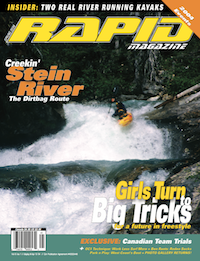Let’s face it: canoes are big boats, and they can be difficult to paddle. The result is that we often work too hard paddling whitewater. When teaching open canoeing, I frequently point out the many opportunities to use water features to reduce the effort of paddling rapids. One of my favourites is the wave turn. Suppose you need to turn from facing downstream to facing upstream. Why take a half-dozen strokes to turn your boat when you could use a breaking wave to do the work of spinning the canoe for you?
Wave turns are as much an exercise in water reading as they are in good boat control. To plan a wave turn, scan downstream looking for a breaking wave with a foam pile perpendicular to the current. The best foam piles have aerated water falling from the wave peak down to the wave trough. Small holes work too, but be careful to wave turn only on features that you also would feel comfortable surfing.
The secret to wave turns is boat position. Begin your approach by aiming your bow at the corner of the breaking wave so the bow points toward the foam pile. Accelerate gently so the bow of your canoe hits the white water at the top of the wave crest. The foam pile is not moving downstream and will catch and hold the bow of your canoe. The stern, which is still in the downstream current, will pass the stalled bow. The result is a spin that turns the canoe upstream. Spinning and catching the wave without the canoe sliding downstream requires that you engage a suitable foam pile with correct boat angle, speed and bow placement.
In some ways, spinning and stalling on a wave serves the same purpose as a mid-current eddy pool. What makes this move better is that you can stay on the wave and enjoy a front surf. The true benefit, though, is that you’ve halted your downstream momentum and are ready to stage your next move.
You may decide to front ferry or (as shown) choose to change direction and S-turn to an eddy along shore. Both manoeuvres will seem easy because the cross-current momentum, generated by the brief front surf, carries into your next move.
The wave turn offers all these benefits while requiring minimal strokes—in fact, I didn’t mention one stroke in this entire article. Just stuff your bow into the corner of a breaking wave and let the river do the work. Reducing your effort by using water features, like waves and holes, is the key to making paddling a canoe look easy. Have fun, and don’t work too hard.
Andrew Westwood is a frequent contributor to Rapid and is an open canoe instructor at the Madawaska Kanu Centre.





